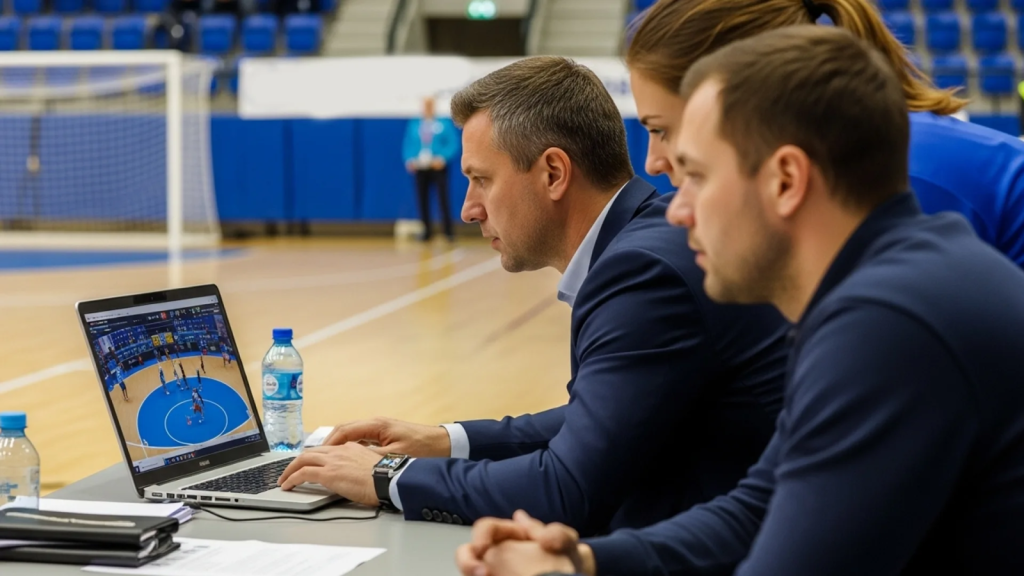Why Frame-by-Frame Analysis Is a Game-Changer in Sports
by Rafey Iqbal, Last updated: June 2, 2025

Frame-by-frame analysis allows coaches and athletes to break down sports footage in extreme detail, revealing subtle technique flaws and tactical missteps often missed in real-time. This blog explores how this method improves performance, reduces injuries, and gives teams a competitive edge.
The final whistle blows, and the score is in. Your team has given its best, fought hard, and played with passion. But despite their best efforts, they still fell short. You, the head coach, are racking your brain, trying to understand what went wrong. Was it a poorly executed pass? A small but crucial misstep? Did the players not respond fast enough to the opposition's tactics? Or were there individual mistakes that cost the team the game?
These scenarios can keep coaches and performance analysts up at night. Without a crystal-clear understanding of these minute details, you are essentially flying blind.
The Need for Precision in a High-Stakes Game
In today’s ultra-competitive sports environment, good isn’t good enough. Teams spend millions of dollars recruiting top-tier talent and hiring top coaches, yet performance gaps persist. While glaring errors and obvious mistakes can be easily identified, the smallest inefficiencies, those often missed in real-time, can be the difference between winning and losing.
These seemingly insignificant factors can profoundly impact a team's performance. A missed pass, a delayed reaction, or a poor defensive assignment can create a chain reaction that leads to a costly turnover or a decisive goal. It is these small but critical errors that separate the champions from the also-rans.
For most sports professionals, real-time video analysis provides only part of the picture. While useful, live footage often moves too fast to catch every nuance and detail. You may think you're seeing the entire game unfold, but crucial moments slip through the cracks.
Here’s the kicker: If you’re not spotting those critical micro-movements, your competition might be.
For example, a soccer team could repeatedly concede goals from set pieces because of a slight misalignment in the defense’s formation. The mistake may be so small that even the sharpest analyst wouldn’t catch it in real-time. Sound familiar?
Missed Opportunities = Lost Games
The consequences of failing to identify and address subtle errors in sports performance can be far-reaching. Imagine losing a series of games because of these minor, elusive errors. It doesn’t just affect your win-loss record. It can affect team morale on and off the field, sponsorships, recruitment, and even your job security. Missed opportunities add up, especially in the high-stakes world of professional sports.
What’s worse is the frustration of knowing something’s wrong but not being able to pinpoint exactly what it is. You’ve reviewed the game footage multiple times, but everything moves so fast that it’s impossible to catch every tiny detail hindering a team's performance.
The consequences? Tactical adjustments based on incomplete or inaccurate information, athletes who aren't optimizing their movements, and teams that keep making the same mistakes game after game.
If this hits too close to home, you’re not alone. Performance analysts, coaches, and sports technologists worldwide face this exact issue daily. The need for precise, granular insights has never been more critical as teams strive to gain a competitive advantage. And this is where frame-by-frame video analysis shines.
Frame-by-Frame Analysis as the Solution to Detailed Performance Breakdown
In the quest for optimal performance in modern sports, frame-by-frame video analysis has emerged as an invaluable tool. This powerful tool is the ultimate solution to the precision problem. By analyzing video footage one frame at a time, you gain access to a level of detail, including every movement, action, and reaction, that’s impossible to catch with the naked eye or even through regular video playback.
Why is this Invaluable?
Because sports happen in milliseconds. A slight miscalculation in timing, positioning, or movement can make all the difference between victory and defeat. With frame-by-frame analysis, these milliseconds become visible and actionable. Let’s break down why frame-by-frame analysis matters:
Spot Hidden Flaws in Technique
In fast-paced sports like basketball, football, or tennis, the speed of play makes it challenging to identify and analyze subtle movements that significantly impact performance. Small movements often go unnoticed in regular video analysis. However, these movements, such as improper foot placement or inefficient follow-through, can drastically impact performance. With frame-by-frame analysis, you can identify and correct these flaws with pinpoint accuracy.
Take tennis as an example. Tennis is a sport that requires precision, consistency, and the ability to perform under pressure. Even the smallest errors in technique can significantly impact a player's performance. One common issue faced by tennis players is an inconsistent backhand. It may only show up in high-pressure situations, such as during tie-breaks or important matches. Without slowing the footage down, you may never notice that the player’s grip subtly shifts in those moments, resulting in weaker shots.
Enhance Tactical Awareness
Team sports rely heavily on tactics, positioning, and sound decision-making. Frame-by-frame analysis allows coaches and analysts to break down complex plays into smaller, more digestible chunks. This gives them a clearer picture of where tactics may have faltered, and how to adjust moving forward.
Imagine watching a basketball player run a pick-and-roll. By viewing the footage frame by frame, you can see exactly when and where the offensive and defensive players are making decisions. Was the pick set too early? Did the defender sag too much? This level of detail helps refine not only player positioning but also team strategy as a whole.
Reduce Injury Risk
In sports medicine, understanding biomechanics is crucial for injury prevention and athletic performance optimization. Small imbalances or improper movement patterns can increase the risk of injury over time. Frame-by-frame analysis helps identify these risks before they become significant issues.
For example, a runner might have a slight inward rolling of the foot (overpronation) that isn’t obvious when viewed in real-time. However, when slowed down and analyzed frame by frame, this issue becomes clear, allowing corrective measures to be taken before injury strikes.
Improve Decision-Making
In many sports, such as football and soccer, decision-making happens in a split second. A quarterback must choose where to pass the ball while being pressured by a blitzing defense. Similarly, a soccer player should decide whether to shoot or pass when approaching the goal.
Frame-by-frame analysis helps break down these crucial moments so that coaches can better understand why players made certain decisions. Was there a better option? Did the player hesitate too long? With this insight, decision-making can be improved through targeted training.
Maximize Efficiency in Training
Frame-by-frame analysis isn’t just for game footage. It’s also an invaluable tool in training for coaches and athletes at all levels. By breaking down practice sessions using this technique, coaches can spot inefficiencies and areas of improvement that would otherwise go unnoticed. This leads to more targeted, effective training sessions, ensuring players develop the skills and techniques necessary for success.
For instance, during strength training or drills, subtle issues in form can have long-term impacts on performance. These issues include improper body positioning, incorrect weight distribution, or inefficient movement patterns. Frame-by-frame analysis helps coaches address these issues early on, ensuring that athletes are trained efficiently and reducing the risk of injury from poor form.
How Frame-by-Frame Analysis Works in Practice
Frame-by-frame analysis typically involves using an enterprise video platform that allows the user to slow down video footage and examine each frame individually. Here’s how it works in a sports context:
Capture High-quality Footage
The first step is recording high-quality footage during games or training sessions. Modern cameras can capture thousands of frames per second, ensuring no detail is missed.
Import Footage into the Video Platform
Once the high-quality video footage has been captured, the next step is to import it into the enterprise video platform. This software provides the tools and features necessary for in-depth footage analysis.
Tag and Review Key Moments
Analysts can tag key moments they want to focus on, whether it’s a specific play (goals, touchdown, or touchovers), an athlete’s movement (successful shots and defensive stops), or a decision-making scenario. Tagging and reviewing key moments facilitates collaboration among coaches, analysts, and athletes, allowing for shared analysis and discussion.
Analyze Frame by Frame
With the footage tagged, the analyst can slow down the video and analyze it one frame at a time. This allows for incredibly detailed breakdowns of movement, positioning, and strategy.
Provide Feedback
Once the video analysis is complete, feedback can be given to the athlete or team. This feedback is data-driven and based on visual evidence, making it far more impactful than subjective observations or anecdotal comments.
Turning Insights Into Action
Using frame-by-frame analysis, teams can make data-driven decisions that directly impact performance. Coaches can implement adjustments based on visual proof, athletes can correct subtle technique flaws, and performance analysts can deliver precise, actionable insights.
This method creates a feedback loop that constantly refines and enhances team and athlete performance. Frame-by-frame analysis turns guesswork into certainty, ensuring that no stone is left unturned when it comes to optimizing performance. This way, teams can gain a competitive advantage by identifying areas of improvement that their opponents may overlook.
Gain a Competitive Edge with Frame-by-Frame Video Analysis for Sports Training
In modern sports, where milliseconds matter, frame-by-frame video analysis provides the granular insight teams need to identify hidden flaws, correct technique, and improve tactical execution. Whether you're analyzing an athlete's footwork or a team’s defensive formation, frame-by-frame analysis turns every moment into a learning opportunity.
A robust video analysis platform enables coaches, analysts, and athletes to slow down footage, tag key plays, and collaborate on performance improvements—all in one place. From reducing injury risks to sharpening decision-making, a video platform with frame-by-frame capabilities empowers teams to perform at their highest level.
Ready to take your sports training to the next level? Start your Free Trial of EnterpriseTube or Contact Us to explore how frame-by-frame video analysis can unlock the full potential of your athletes and elevate your game strategy.
People Also Ask
What is frame-by-frame analysis in sports?
Frame-by-frame analysis is a technique used to review sports video footage one frame at a time, providing coaches and analysts with a precise view of every movement, decision, and play.
How does frame-by-frame analysis help prevent sports injuries?
It helps detect subtle biomechanical issues—like improper form, foot placement, or joint stress—that could lead to injuries if left uncorrected, enabling early intervention and safer training.
Can frame-by-frame analysis improve player performance?
Yes, it allows athletes to refine their technique by identifying small flaws in movement and timing that are typically missed in real-time video playback, leading to measurable performance gains.
Why is frame-by-frame analysis better than regular video playback?
While regular video playback shows general gameplay, frame-by-frame analysis reveals micro-movements, delayed reactions, and tactical missteps that are crucial for elite performance improvement.
What sports benefit from frame-by-frame video analysis?
Frame-by-frame analysis benefits a wide range of sports, including football, basketball, soccer, tennis, swimming, and track and field—any sport where timing and technique are critical.
What tools are needed for frame-by-frame sports analysis?
You’ll need high-resolution video recording equipment and an enterprise video analysis platform that supports frame-by-frame playback, tagging, and collaboration features.
Can frame-by-frame analysis help with team tactics and strategy?
Absolutely. It enables coaches to break down plays into individual components, helping teams understand positional errors, missed cues, and tactical breakdowns more clearly.
How often should sports teams use frame-by-frame analysis?
Teams should use it regularly, after games and during training, to monitor progress, reinforce strategies, and consistently optimize both individual and team performance.
Is frame-by-frame analysis useful for youth or amateur athletes?
Yes, it’s highly beneficial at all levels. Youth and amateur athletes can gain a clearer understanding of their techniques early on, leading to better development and fewer bad habits.
Do I need technical expertise to use frame-by-frame analysis software?
Most modern platforms are user-friendly. However, basic training or onboarding can help users unlock the full capabilities and extract deeper insights from the video footage.
Jump to
You May Also Like
These Related Stories

From Old Seminar Footage to an AI-Powered Video Library for Sports Coaches

Why Your Sports Federation Needs a Secure Video Platform (And Why YouTube Isn’t Enough)



No Comments Yet
Let us know what you think